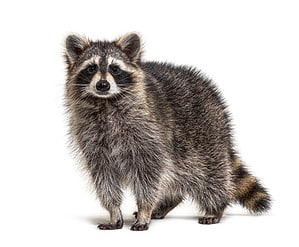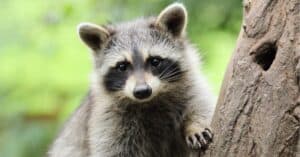It’s a scenario that haunts every homeowner: you’re lying in bed, or enjoying a hobby, when you suddenly hear something in your attic. When you go to explore, you find torn insulation, damage to your property, and a mess that you’re not quite sure how to clean. How do you rectify raccoons in your attic? Should you call Wildlife Control? Is it safe to clean yourself? We have all the tips on how to safely handle this situation, as well as prevent it from happening again.
What are Raccoons?

Raccoons live in colonies. Chances are high that a single raccoon in your attic will quickly become several.
©Georgi Baird/Shutterstock.com
Raccoons are native to North America. They’re mammals, the largest of the procyonid family. Commonly incorrectly classified as rodents,the procyonid family includes kinkajous and coatis. Raccoons typically live for up to three years in the wild, and can grow to weigh as much as 20 pounds. They’re nocturnal, and live in colonies of up to 23 members. Mother raccoons nurse and raise their young until they reach an age of two to three months, however, their offspring may live in the colony past this age. Raccoons are omnivores, meaning they rely on both meat and plant sources for nutrition. In the wild, they eat vegetation, berries, fruits, bugs, frogs, fish and rodents. Raccoons have a high level of intelligence and dexterity, as they have small, flexible, five-fingered hands. This combination has made raccoons successful at scavenging through trash recepticles and adept at finding entry into buildings.
Signs of Raccoons in the Attic
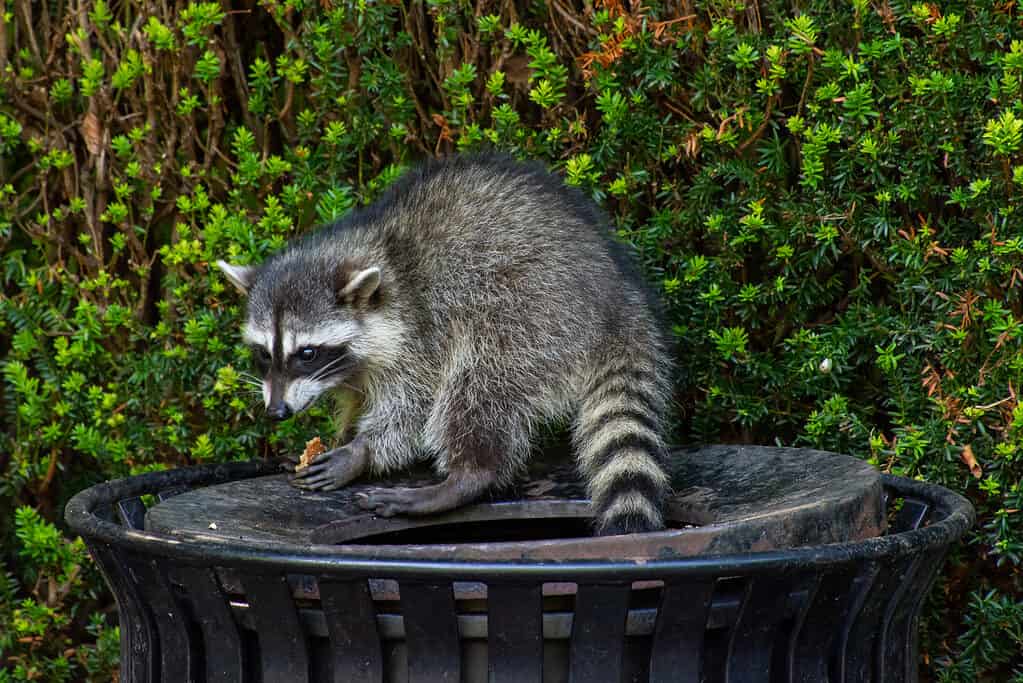
Raccoons are intelligent and crafty. In urban areas, they commonly find ways into buildings or congregate in parks or other high-traffic areas, in order to take advantage of easy meals.
©kingma photos/Shutterstock.com
Raccoons can live in a building for some time without detection. They’re typically very quiet animals that are only active at night. Signs that you may have an infection include:
- Stains on the interior ceiling.
- Faint chirping, chittering, thumping, or running sounds at night.
- External signs of entry, including soffits pulled away from the side of the building or foundation vent holes.
- Scratches on your home’s exterior.
- More frequent sightings of raccoons in your yard.
- Raccoon waste inside your attic or vents.
- Property damage including tunnels in attic insulation.
Why do Raccoons Move Into your Attic?
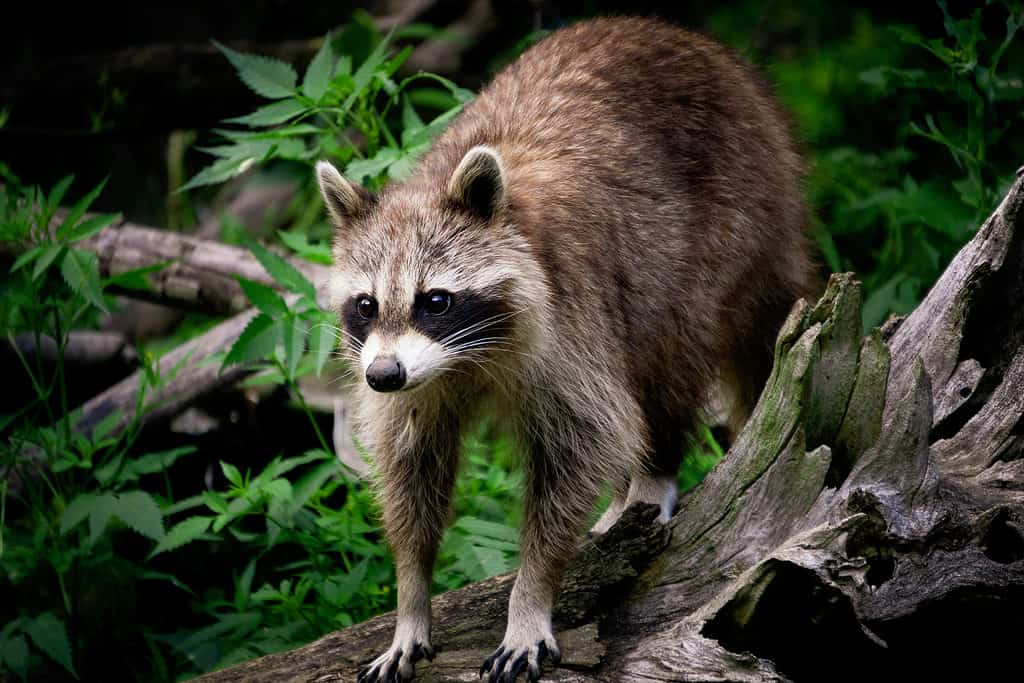
Raccoons are opportunistic, meaning they’ll take advantage of a chance to establish a home in a protected environment.
©John Wherley/Shutterstock.com
Raccoons are like most animals. If provided with an opportunity to establish a den in a warm area protected from the elements, they’ll quickly move in. Most raccoons will choose an abandoned building over one inhabited by humans. Urban raccoons may invade buildings that are in use,as the presence of people doesn’t disturb them. Female raccoons are more likely to invade your home than male raccoons, particularly in the late spring and summer months. This is the time of year that most raccoons give birth. Each brood typically contains five to seven baby raccoons, called kits. Once in your attic, the raccoons are unlikely to leave on their own. After they become adults, they’re more likely to stay within the area of your home. Adult females may return to your attic when they have broods of their own. Removing them quickly is the best way to avoid this situation.
Safety Concerns of Raccoons In the Attic
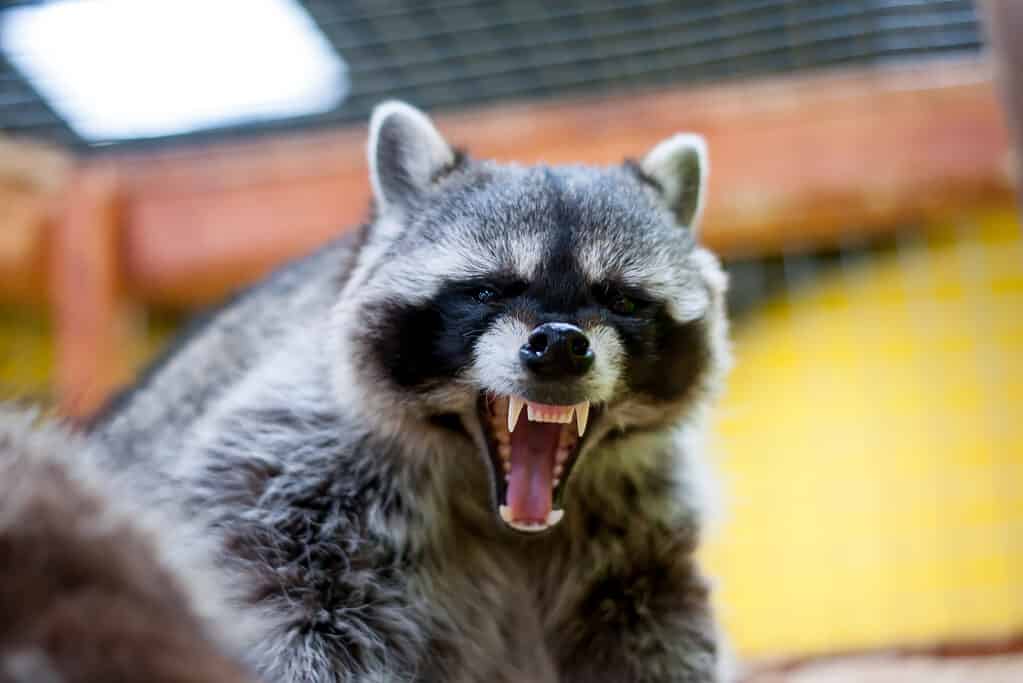
Racoons may look cute and cuddly, but they’re wild animals. Never approach any wild animal, as they may bite.
©Vital9s/Shutterstock.com
Dangers to the Home
Raccoons are destructive once within a home. They burrow through the insulation in your attic and potentially damage your home’s wiring while creating nests. In addition, the holes and damage that they create to the exterior of your home while gaining entry allow insects, moisture and debris inside your home, which can contribute to mold growth. Despite this, raccoons are clean animals. In a community, they will select a specific area to use as bedding, as well as an area for use as a bathroom. Unfortunatley, the concentration of waste materials to a specific area of the home can cause rapid damage and contamination, requiring specialized removal.
Dangers to Your and Your Pet’s Health
In addition to fleas and ticks, raccoons can carry numerous potentially harmful bacteria, parasites and viruses for humans. Called zoonotic illnesses, these are illnesses that can transfer from animals to humans. Transfer of the disease is generally through direct exposure, such as a bite or scratch, or exposure to the animal’s waste. In the case of raccoons, either exposure can be harmful to your health. Raccoons are capable of carrying rabies. Rabies is present in saliva and spreads when an infected animal bites or scratches. Proper vaccine treatment within 48 hours of exposure is recommended.
Other illnesses carried by raccons can be transferred to humans through exposure to the animal’s waste products. Raccoons are often host to a specific roundworm that can infect both humans and their pets if exposed. Giardiasis, spread through direct exposure or contact with contaminated surfaces, is present in raccoon waste. Symptoms include intestional discomfort, leading to dehydration. Salmonella, present in raccoon waste, can cause a potentially fatal severe illness in humans. Leptospirosis, a bacteria found in raccon urine, waste or contaminated surfaces, can cause serious illness. Bacteria based, the illness causes migraines, flu-like symptoms and muscle pain.
Best Practices for Removal
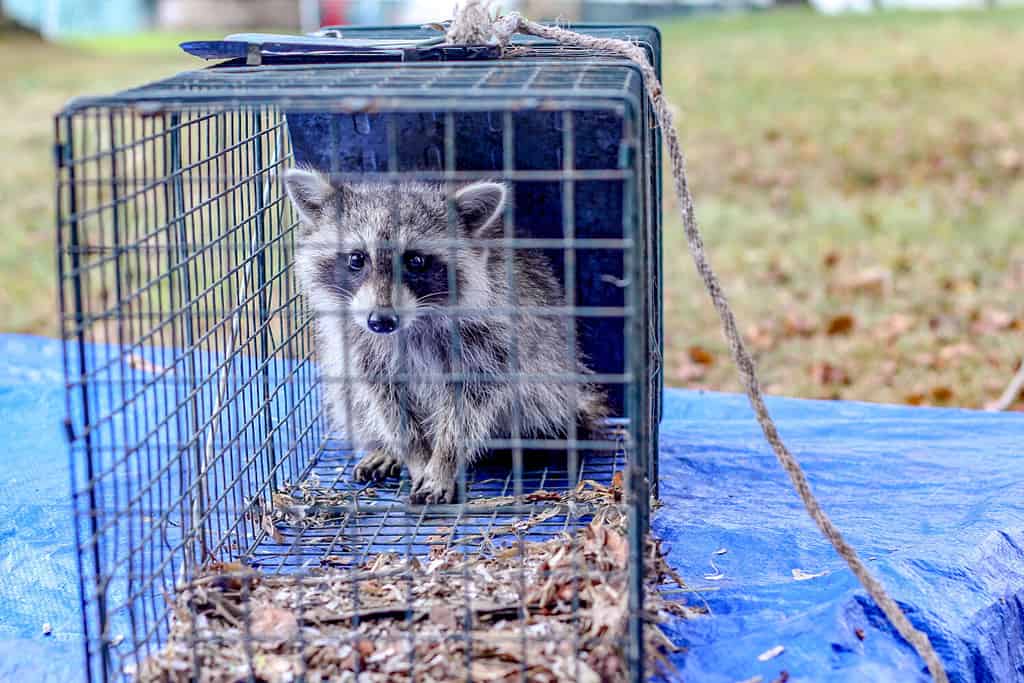
It’s best to contact professional help with raccoon removal.
©Chris Wetherell/Shutterstock.com
Safe removal by certified wildlife technicians is the best choice for raccoon removal. Many city governments offer this service on their municipal websites. Wildlife rescue will trap and remove the animals, relocating them to a safe spot away from neighborhoods to prevent reinfestation. If you’re determined to remove the raccoons yourself, you will need to obtain humane traps. If a raccoon has a litter of kits in your attic, you can gently place the kits in the trap. It’s important to only attempt this if the mother raccoon is not present, as she may attack if her nest is disturbed. Be sure to wear gloves if you handle the kits. Always ensure that there isn’t a missed nest by checking disturbed insulation thoroughly.
If there is no litter of baby kits, lure the raccoon into the trap with bait. Once captured, take the raccoon to an area where they can reestablish a home.
How to Clean After Removal
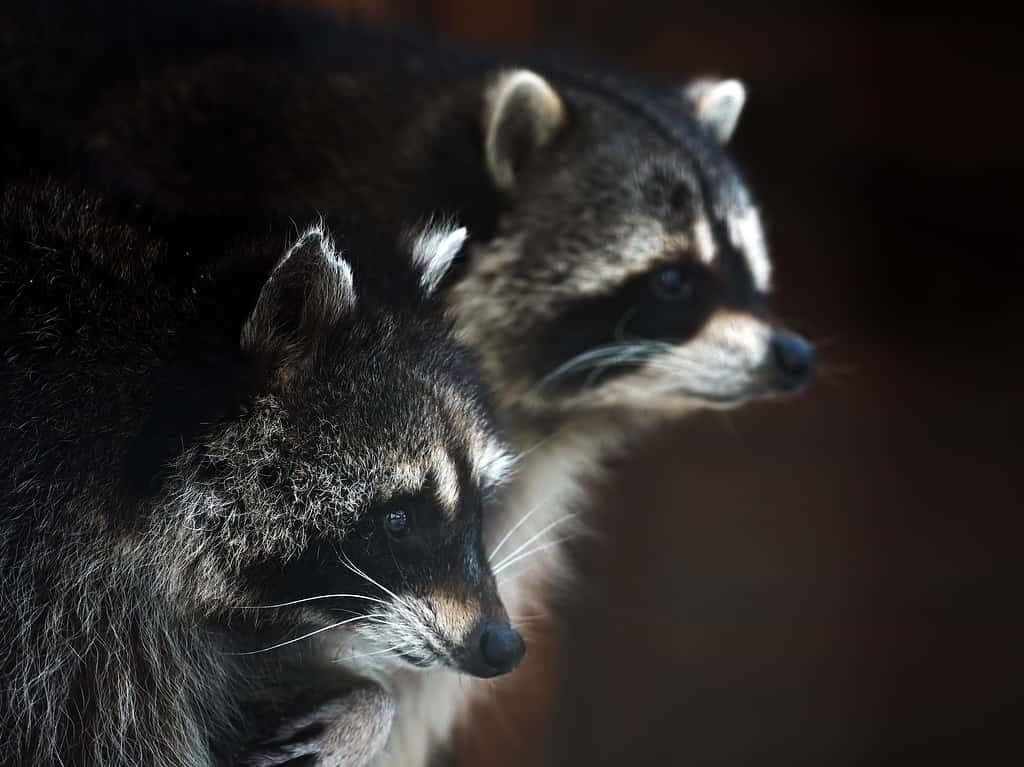
They may be cute, but the damage raccoons cause can be extensive.
©iStock.com/SergeiM
Once the raccoons are removed, you’re faced with the task of cleaning the mess left by their dens. While some home owners prefer to hire cleaning companies to sanitize the area, others choose to rectify the situation themselves. If you prefer to hire a business, be sure to let them know that you’re cleaning a raccoon infestation. The potential dangers of exposure to raccoon wastes require specialized equipment to safely clean the area. Likewise, if you chose to undertake the task, you should ensure that you have proper equipment. You’ll need a respirator, heavy gloves, and heavy bags to place contaminated materials in. Roundworm eggs, as well as Leptospirosis bacteria, can remain dormant in waste matter for a considerable period of time. Disturbing the area can cause these pathogens to become airborne.
The CDC recommends misting the area with water to limit disturbing materials, removing the contaminated sections with a shovel into a plastic bag, and burning, burying or taking the bags to a waste facility for disposal. All tools should be sanitized with boiling water. Any clothing worn during the cleaning process should immediately be washed and dried, and hands or other areas should be cleaned with soap and water.
Prevent a Future Raccoon Infestation
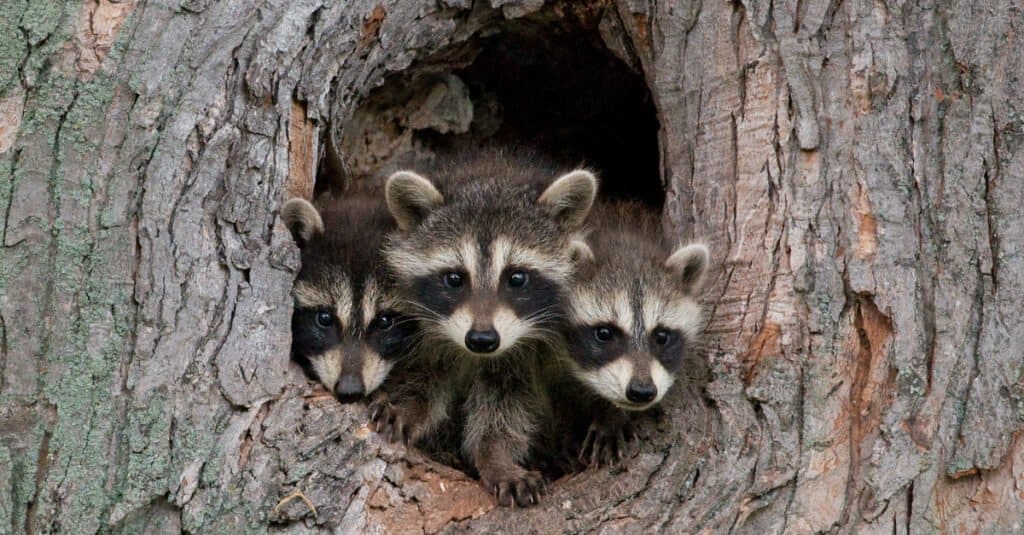
Admire racoons from a distance by protecting your home from entry.
©Gerald A. DeBoer/Shutterstock.com
Once raccoons are removed from your attic, you should repair any entry holes they made during their stay. It’s important to note that raccoons, once inside your attic, may have made secondary holes. Inspect your roof, soffits, and vents for damage. Once repaired, take the time to repeat this inspection annually. Take note of any far-reaching or low-hanging branches that may have been used by raccoons to access your roof and trim them back. Likewise, move exterior trash bins away from drainage pipes or other structures raccoons may have used to climb and gain entry. If your yard contains fruit trees, promptly removing fallen fruit can help deter raccoons, as can placing locking lids on your garbage bins. Pest-control sprays can be purchased either from retail locations or local companies that assist in repelling raccoons from your attic and foundation.
Thank you for reading! Have some feedback for us? Contact the AZ Animals editorial team.





